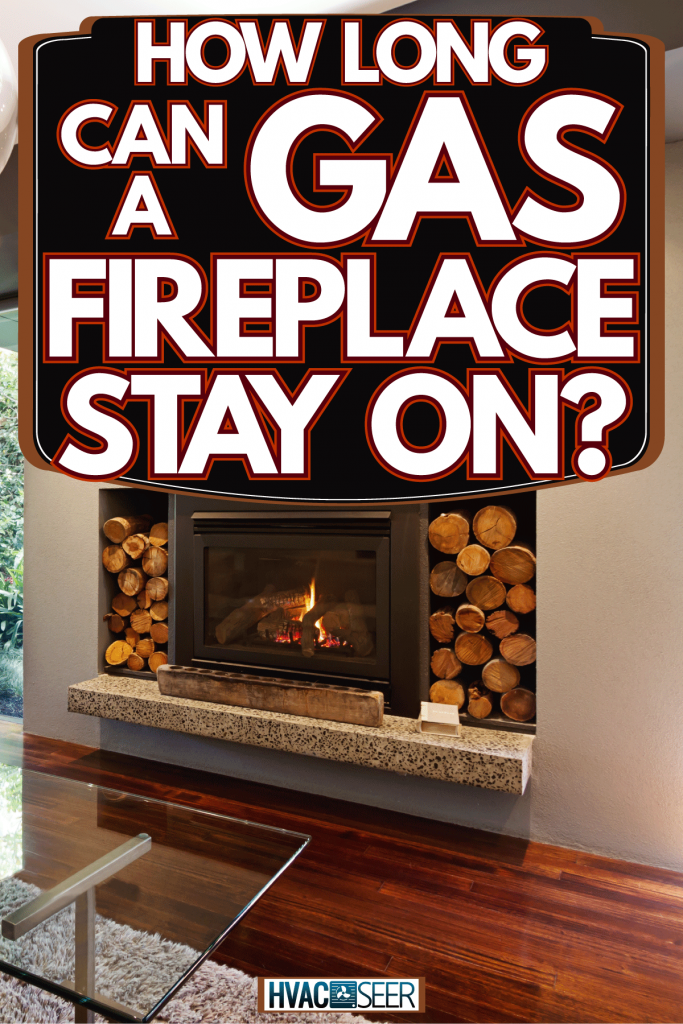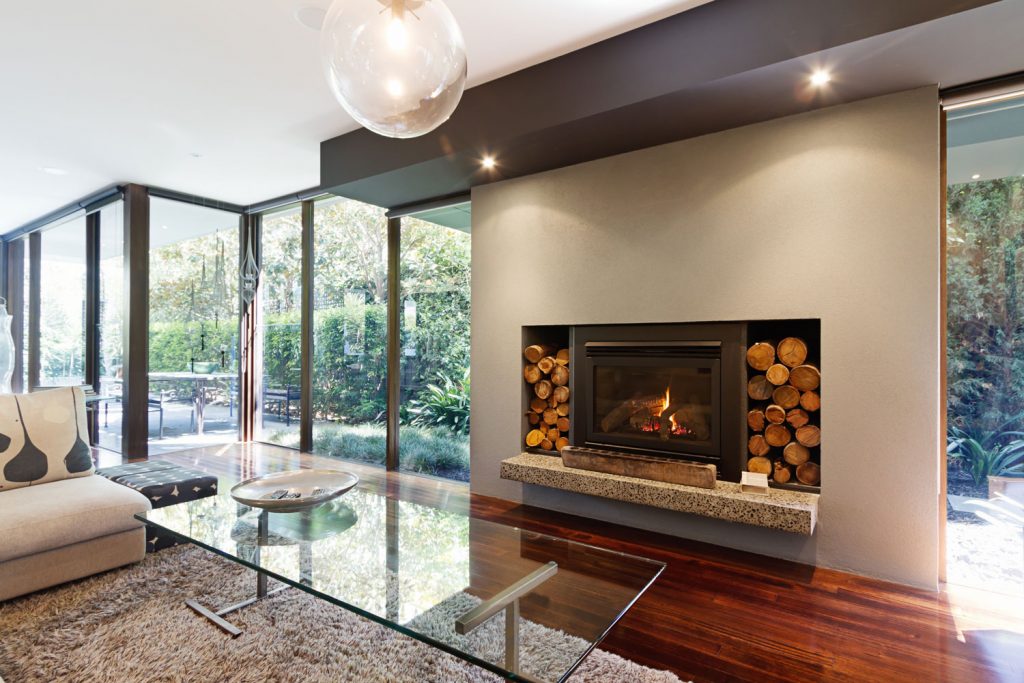There is nothing better than snuggling up by a fire during the cold winter months. However, if you own a gas fireplace, you may be wondering how long you should leave it on? We have taken the time to answer this question in this article.
Depending on the type of gas fireplace you have will determine how long it can stay on. For example, direct vent fireplaces that are sealed can run continuously without turning off. In comparison, vent-free gas fireplaces should not be run for more than 2-3 hours at a time.
Like any fireplace, gas fireplaces should be run as recommended by their manufactures to void damages or harmful situations. This article will look at the two types of fireplaces and how long they should be on for. In addition, we will take a closer look at other frequently asked questions about gas fireplaces, so read on!

How Long Can A Gas Fireplace Stay On?
Direct vent gas fireplaces have sealed combustion. This means that oxygen is not needed to produce a flame and, therefore, can be placed in locations where a standard vented fireplace cannot go.
Direct vent gas fireplaces do not need to be turned off when left for more extended periods because they are sealed and released outside the fumes. However, these fireplaces should still be vented through an exterior wall or roof, just like a standard vented fireplace.
The venting system will travel indoors to the room of your choice and then out again into the exterior wall or roof. This prevents carbon monoxide poisoning by ensuring that poisonous fumes are released outside instead of inside.
Now, let's talk about vent-free gas fireplaces. Vent-free gas fireplaces are not sealed, and therefore oxygen is needed to produce a flame.
This type of fireplace has a sensor that detects the amount of oxygen in the air and then turns on and off accordingly. Therefore, it will only run the amount of time it needs for your home to get to the appropriate oxygen level.
Vent-free gas fireplaces should not be used for longer than 2-3 hours at a time due to concerns about carbon monoxide poisoning. You always recommend not to use your vent-free fireplace in an enclosed space, such as a bedroom.

Making Sure Your Gas Fireplace is Safe to Leave On
The best way to make sure that your gas fireplace is safe to leave on is by contacting customer support for your specific model. They will tell you how long it can be left on and recommended safety precautions.
Several reputable companies produce fireplaces for homes. These companies, such as Napoleon and Dimplex, sell fireplaces that produce gas and can be left on without worrying about carbon monoxide poisoning or a possible fire.
Another essential safety feature is the timer. This enables you to control how long your fireplace stays on when there are no occupants in the room where it is located.
These fireplaces come equipped with a wide range of safety features, and this is why they can be left on without worry.
Can you get carbon monoxide poisoning from a gas fireplace?

Carbon monoxide poisoning is a real danger, and you should always exercise caution and care when using your fireplace. If you have a gas fireplace, never use it in an enclosed room such as a bedroom or bathroom.
A vent-free gas fireplace emits dangerous carbon dioxide into the air that may cause harm if there is not enough ventilation. Vent-free gas fireplaces are stated to be safe by manufacturer regulations, but they are not recommended to be used in enclosed spaces.
A direct vent gas fireplace will emit carbon monoxide, but only if it is not adequately vented. If the fumes are released indoors, they can cause serious health problems for you or your family members.
The best way to prevent this from happening is by making sure that you have a direct vent gas fireplace installed by an experienced company. If your fireplace is installed correctly, you shouldn't have to worry about carbon monoxide poisoning.
A direct vent gas fireplace is the safer choice than a vent-free fireplace because it allows air in and ensures that no harmful fumes are released inside your home.
If you want to keep your family safe, make sure to take these precautions and if you have any concerns about carbon monoxide poisoning, contact your local fire department.
Can you sleep with a gas fireplace on?
Not only do you run the risk of carbon monoxide, but if a fire starts while you are sleeping could be life-threatening. Therefore, it is best to turn your fireplace off when you go to sleep or leave home for an extended period of time. Whether it is a gas, electric, or log-burning fireplace, it is a good idea to have them turned off or put out before going to bed.
It is generally safe to use gas fireplaces, but only if installed according to the manufacturer's specifications and maintained regularly. Some companies can set up a program to inspect your fireplace yearly to ensure the installation was done correctly and safely.

Do gas fireplaces shut off automatically?
Most new gas fireplaces have a safety shut-off valve if the pilot light goes out. So if you have a new gas fireplace, the chances are that it has this feature. In addition, a lot of these newer gas fireplaces have an automatic gas shut-off if the fireplace gets too cold or if there is a carbon monoxide build-up.
You can also get gas fireplaces that come with a remote. The remote is like a thermostat that controls the temperatures and has a timer setting. This is a handy feature if you don't want to manually turn your gas fireplace on and off.
Is it OK to leave the pilot light on in a gas fireplace?
A pilot light usually stays on to generate the heat needed for a gas fireplace. The pilot light is a small, easily controlled flame that stays on even when the fireplace is turned off.
If the pilot light goes out, you will have to relight it for your fireplace to work again. It is suggested that you only use the remote control to turn on and off your gas fireplace, so you don't have to risk going near the pilot light.
Even if your fireplace is only used occasionally, it is recommended that you follow certain safety steps even when it is not in use. You should keep all flammable materials at least three feet from the firebox opening and above the mantle. Ensure that there are no combustible materials between your fireplace and the chimney.
Can gas fireplaces explode?
Gas fireplaces are very convenient due to their quick heating, but they can also be dangerous if not correctly installed and maintained. Gas fireplaces can leak, which can lead to an explosion.
If you smell gas or see a yellow or orange flame coming from your fireplace, then it needs to be turned off immediately. You should never use a lighter or match to try and light the pilot light. This can cause an explosion that may expel debris from your home and ruin your fireplace.

Is an electric or gas fireplace better?
If you want a fireplace and an environmentally friendly fire, then an electric fireplace may be the solution. An electric fireplace uses electricity to produce heat and flames.
An electric fireplace can come with or without heat. You will have to decide whether you want its aesthetics for your home decor or if you want something that emits heat.
Electric fireplaces are safe because they do not emit harmful gases into the air. If you have children or pets, this option may be better because it will keep them away from the flames of a traditional fireplace.

A gas fireplace is great for those who want an actual flame but do not want the hassle of starting a fire. Gas fireplaces are designed to recreate an actual wood-burning or gas-burning fireplace and emit heat into your home just like the original ones.
The one major downside to having a gas fireplace is that it can be dangerous if they do not have proper ventilation to remove harmful fumes. Also, never use a gas fireplace if the pilot light goes out without turning it off properly.
Final Thoughts

Overall, gas fireplaces are a popular way to heat a home. However, you need to take precautions and be aware of any gas smells or leaked carbon monoxide. Ensure that you have an excellent working smoke and carbon monoxide detector in your home and follow the manufacturer's recommendations for the use of your fireplace.
For more articles like this one, check out our website:
Gas Fireplace Won't Start – What To Do?
